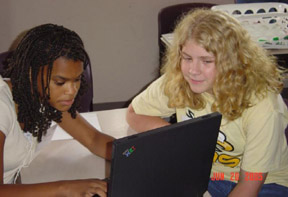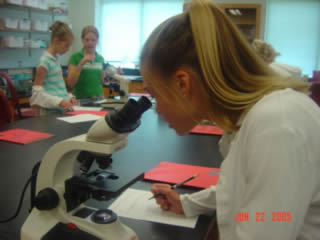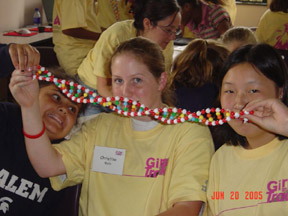CSC News
Keeping Girls On Track

At the end of this year’s Girls on Track (GoT) summer camp (June 20-24), camper Heather Barnes told a counselor, “I’m definitely coming back to camp next year! I had so much fun…. Are you coming back too?”
This is the seventh Girls on Track camp since the program first began in 1999. The camp focuses on keeping middle-grade girls interested in math and science. Camp activities center around the use of computers and technology to solve problems. By familiarizing girls with information technology, the camp organizers hope to raise interest in careers and courses where women are often underrepresented.
CSI: Campers Start Investigating
 The campers’ first investigation focused on the education and salaries tied with careers. From artist to programmer to zoologist, the campers concluded that the more schooling a career requires—particularly in math and science—the higher the salary. The girls discovered that IT careers require “all the math” and yield significant salaries.
The campers’ first investigation focused on the education and salaries tied with careers. From artist to programmer to zoologist, the campers concluded that the more schooling a career requires—particularly in math and science—the higher the salary. The girls discovered that IT careers require “all the math” and yield significant salaries.
At the end of the career investigation, camp director Lolita Tripp burst into the room and shouted, “Hey everyone! You’ve got to come—I just a skull, blood, some hair and fibers, and a note…. I don’t know what happened, but let’s find out!” Campers were led to the “crime scene” and collected evidence to solve the “Mystery of the Missing Skull.” Throughout the week, the girls used blood typing and gel electrophoresis to study the blood found at the scene, chromatography tests to determine the type of ink on the note, dichotomous keys to discover what kind of animal the skull was from, and microscopes to analyze the hairs and fibers.
Math and The Arts
Maria Droujkova, NC State Ph.D. graduate and founder of Natural Math, led the girls in an investigation of math as the backbone of art and dance. A visit to the North Carolina Museum of Art provided background for a discussion of how proportion, ratios, perspective, symmetry, and patterns are used in painting and sculpture to produce the desired visual effects.
Kirstie Tice, co-founder and director of the NC Dance Institute, helped campers choreograph their own dances. They linked math concepts such as angles, degrees, symmetry, and sequence to the movements in dance. After a few days of practice, the girls danced for their parents and received much applause.
Gaming
Tiffany Barnes, an NC State Computer Science Ph.D. graduate and professor at UNC-Charlotte, taught campers how to create their own computer games. Using the program Game Maker, the girls created games using a process similar to programming in Java. Within a few days, the girls progressed from a tutorial “bouncing clown” game to their own, more complex platform and maze games.
Pulling It All Together
 At the end of their five days at Girls on Track, the campers prepared presentations for their parents on what they learned. They showed that blood type can be determined through the use of antigens and that black pen ink consists of different colors. They explained the role of proportion in realism and abstract art, the evidence that the hair and fiber from the crime scene were cat and cotton, the steps involved in creating a game, and the procedure for distinguishing a muskrat skull from a hawk skull. In the end, the most important thing they learned was as camper Maggie Holsinger said, “All that math and science pays off!”
At the end of their five days at Girls on Track, the campers prepared presentations for their parents on what they learned. They showed that blood type can be determined through the use of antigens and that black pen ink consists of different colors. They explained the role of proportion in realism and abstract art, the evidence that the hair and fiber from the crime scene were cat and cotton, the steps involved in creating a game, and the procedure for distinguishing a muskrat skull from a hawk skull. In the end, the most important thing they learned was as camper Maggie Holsinger said, “All that math and science pays off!”
In addition to its role as an intervention program, Girls on Track is a 7-year longitudinal study on why girls make the course and career choices they do. As a joint project between N C State University’s Department of Computer Science and the Center for Research in Mathematics and Science Education, GoT follows the progression of its campers as they move through middle school, high school, and college.
Girls on Track is made possible through the help of Meredith College, where the camp has met since 1999, and funding from the National Science Foundation and IBM.
by Irene Rindos
Return To News Homepage